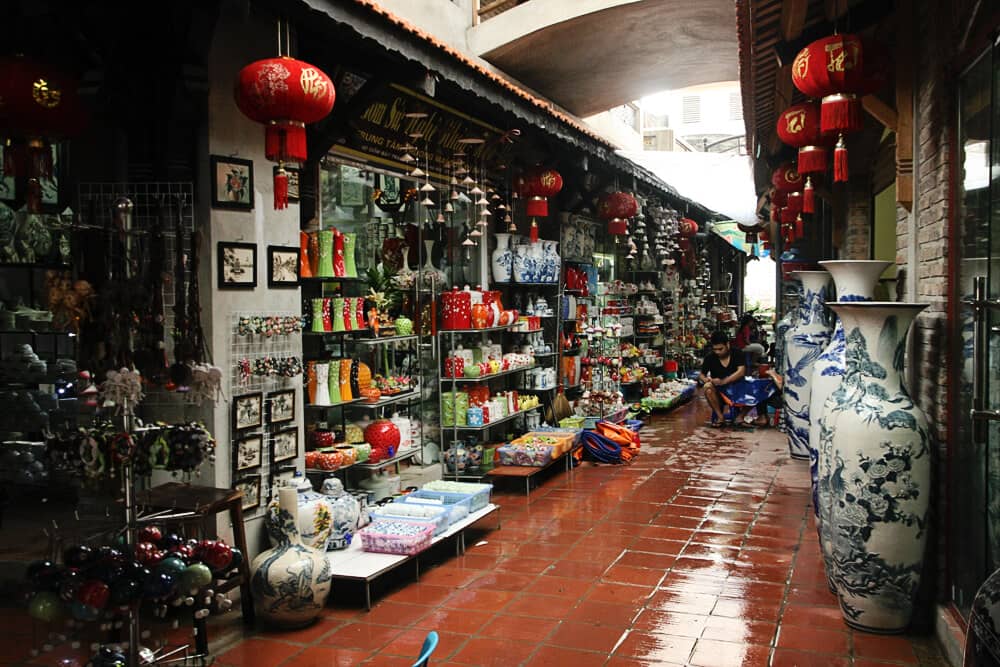News
Recognize the Role of Bat Trang Ceramics in Vietnamese Culture
Bat Trang ceramics have long been celebrated as an emblematic element in Vietnamese cultural heritage. Originating from the Bat Trang village, located near Hanoi, this craft represents not only artistic skill but also centuries of tradition and cultural identity. The unique blend of functionality and aesthetic value found in Bat Trang ceramics makes them a pivotal component in understanding Vietnam’s rich history and socio-cultural development.
Historical Significance of Bat Trang Ceramics

The historical background of Bat Trang ceramics is foundational to appreciating their role in Vietnamese culture. This section explores how the craft has evolved through various dynasties and how it reflects broader historical trends.
Before delving into specific periods, it’s essential to recognize that Bat Trang’s location along the Red River allowed for the optimal conditions for pottery production—from the clay quality to trade opportunities. This geographical advantage contributed significantly to the village’s prominence.
Origins and Early Development
The origins of Bat Trang ceramics date back over 700 years, with the earliest records pointing to the Ly dynasty (1009–1225). During this period, ceramics were primarily utilitarian, used in daily household activities. However, even then, the craftsmanship showed remarkable attention to detail and durability.
Ceramic pieces from this era often featured simple designs and shapes, reflecting the practical needs of the society. Yet, the meticulousness of the artisans indicated a deep-rooted cultural appreciation for pottery, hinting at its future significance beyond mere utility.
Influence Through Dynastic Changes
Successive dynasties—the Tran, Le, and Nguyen—left distinct imprints on Bat Trang ceramics. Each had different requirements and tastes that shaped the form, decoration, and techniques employed by potters.
For instance, during the Tran dynasty, religious and ceremonial uses became more prominent, leading to the creation of items such as Buddhist statues and ritual vessels. This shift highlighted the evolving role of ceramics in spiritual and social practices.
Under the Nguyen dynasty, there was increased exposure to international trade, which introduced new artistic influences and materials. Pottery styles began to incorporate more ornate patterns, including floral motifs and intricate glazes, signaling both economic prosperity and cultural openness.
Bat Trang Ceramics in Trade and Cultural Exchange
Bat Trang ceramics were not confined within Vietnamese borders; they played a vital role in regional trade networks. The village became known internationally, exporting ceramics across Southeast Asia and even to Europe.
This commercial success underscored the high quality and desirability of Bat Trang products, establishing Vietnam as a significant player in the global ceramic market. Moreover, the exchange facilitated cross-cultural interactions, enriching Vietnamese ceramic art with foreign influences while maintaining its distinct identity.
Artistic and Technical Characteristics of Bat Trang Ceramics

Understanding the artistry and craftsmanship behind Bat Trang ceramics reveals why these artifacts are so treasured. This section focuses on the distinctive technical methods and aesthetic qualities that define Bat Trang pottery.
Bat Trang ceramics embody a harmonious blend of tradition and innovation, where artisans balance functional design with elaborate decoration.
Unique Clay and Material Composition
One of the defining features of Bat Trang ceramics is the particular type of clay used, sourced locally from the Red River banks. The clay’s fine texture and purity contribute to the ceramics’ strength and smooth finish.
Potters employ meticulous processes to prepare the clay, removing impurities and achieving the right consistency. This preparation stage is crucial for ensuring that the final product can withstand firing without cracks and maintains a refined surface suitable for glazing.
Traditional Techniques and Firing Methods
Artisans utilize age-old techniques passed down through generations, combining hand molding, wheel throwing, and carving. These approaches allow for a wide range of shapes, from everyday bowls and plates to intricate vases and figurines.
Firing is another critical step, traditionally done in wood-fired kilns that reach temperatures exceeding 1200°C. This method lends a characteristic hardness and subtle color variations to the ceramics, distinguishing them from mass-produced alternatives.
Distinctive Decorative Styles
Decoration on Bat Trang ceramics varies widely, featuring motifs inspired by nature, folklore, and mythology. Common themes include lotus flowers, dragons, phoenixes, and geometric patterns.
Artisans apply decorations using techniques like underglaze painting, relief carving, and colored enameling. This diversity allows each piece to tell a story or convey symbolism, enhancing both its visual appeal and cultural meaning.
Cultural and Social Impact of Bat Trang Ceramics

Beyond their physical beauty, Bat Trang ceramics hold profound cultural and social significance. They are interwoven with Vietnamese customs, beliefs, and community life.
This section examines how these ceramics function within celebrations, daily living, and cultural preservation.
Ceramics in Vietnamese Rituals and Traditions
Bat Trang ceramics play integral roles in many Vietnamese rituals, including weddings, ancestor worship, and Tet (Lunar New Year) festivals. Specific types of pottery are chosen for symbolic reasons, reflecting values like prosperity, longevity, and respect for ancestors.
For example, incense burners and offering bowls made from Bat Trang ceramics are central to altar setups, emphasizing the spiritual connection between the living and deceased family members.
Everyday Life and Household Uses
In everyday Vietnamese life, Bat Trang ceramics serve practical purposes, such as cooking pots, storage jars, and dining ware. Their durability and aesthetic qualities make them preferred choices for households, blending functionality with cultural expression.
These ceramics often become family heirlooms, passed down through generations, which helps maintain a tangible link to ancestral heritage.
Community and Artisan Identity
The craft of Bat Trang ceramics fosters a strong sense of community identity among the villagers. Artisans take pride in their skills, viewing their work as part of a collective cultural legacy.
Efforts to sustain and promote the ceramic tradition have led to local festivals, workshops, and tourism initiatives. These activities not only boost the economy but also ensure the transmission of knowledge to younger generations, safeguarding cultural continuity.
Contemporary Relevance and Challenges Facing Bat Trang Ceramics
As modernity brings rapid changes, Bat Trang ceramics face both opportunities and challenges. This section explores how the craft adapts to contemporary demands while addressing issues threatening its survival.
The balance between preserving tradition and embracing innovation is a key theme in the ongoing evolution of Bat Trang ceramics.
Modern Innovations and Market Adaptations
To stay relevant, artisans have introduced new designs, incorporating contemporary aesthetics and functionalities. Collaborations with designers and export-oriented production have expanded the reach of Bat Trang ceramics globally.
Such innovations demonstrate the craft’s dynamism and capacity to evolve without losing its core identity, appealing to modern consumers seeking authentic cultural products.
Environmental and Economic Pressures
Despite renewed interest, Bat Trang ceramics confront environmental concerns such as resource depletion and pollution from kiln emissions. Additionally, competition from cheaper industrial ceramics challenges the economic viability of traditional artisans.
Addressing these pressures requires sustainable practices, government support, and consumer awareness to protect the craft’s future.
Preservation Efforts and Cultural Promotion
Various organizations and local authorities have launched initiatives to document Bat Trang’s history, train young artisans, and promote ceramics as cultural tourism attractions.
These efforts highlight the recognition of Bat Trang ceramics as invaluable cultural assets, deserving protection and celebration in the face of globalization.
Bat Trang Ceramics as a Symbol of Vietnamese National Identity
Bat Trang ceramics transcend their material form to embody national pride and identity, symbolizing Vietnam’s resilience, creativity, and cultural richness.
This section analyzes how these ceramics contribute to shaping and expressing Vietnamese identity at home and abroad.
Representation in Arts and Media
Bat Trang ceramics frequently appear in Vietnamese literature, visual arts, and media as symbols of tradition and heritage. Documentaries, exhibitions, and publications celebrate the craft, raising public awareness of its cultural importance.
These representations reinforce a collective sense of belonging and continuity amid societal transformations.
Role in Tourism and Cultural Diplomacy
As a major tourist attraction, Bat Trang draws visitors eager to experience authentic Vietnamese culture firsthand. The ceramics industry serves as a platform for cultural exchange and diplomacy, showcasing Vietnam’s artistic achievements.
Through international fairs and collaborations, Bat Trang ceramics contribute to Vietnam’s soft power, fostering mutual understanding and appreciation globally.
Educational Value and Cultural Transmission
In educational contexts, Bat Trang ceramics offer tangible connections to history, art, and traditional knowledge. Schools and cultural centers use the craft to teach students about Vietnamese heritage, encouraging respect and curiosity.
By integrating Bat Trang ceramics into curricula and public programs, Vietnam ensures that younger generations recognize and value their cultural roots.
Conclusion
Bat Trang ceramics hold a distinguished place in Vietnamese culture, encapsulating centuries of history, artistry, and social meaning. From their humble beginnings in a riverside village to their status as national symbols, these ceramics reflect the enduring spirit and creativity of the Vietnamese people. They serve not only as functional objects but also as carriers of cultural memory and identity. Amid contemporary challenges, the continued appreciation and preservation of Bat Trang ceramics affirm their vital role in shaping Vietnam’s past, present, and future cultural landscape.
